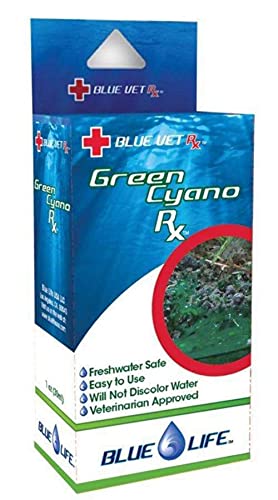Best Hair Algae Eater Reef (2024 Update)
Maintaining a thriving reef aquarium requires keeping algae growth under control. Hair algae, in particular, can quickly overrun the tank and smother corals if not promptly dealt with. Selecting the right clean-up crew members to eat this pesky algae is key. When shopping for the best hair algae eater for a reef tank, owners should consider their fish stocking, tank size, algae extent, and each species’ reef compatibility and tank requirements.
Will the algae eater get along with tank mates or become aggressive? How large will the fish grow? Does it prefer to munch hair algae or leave scraps behind? Before buying, research the types of hair algae eaters available and their unique traits. Compare which is suitable for the tank inhabitants and environment.
Some questions to ponder: Is my reef tank already stocked with docile community fish or territorial, aggressive varieties? Do I need just a few algae grazers or a squadron to handle the hairy algae bloom? Is my tank mature and stable or still cycling with fluctuating water parameters? How thick are the algae mats? Nibblers may work for spot algae while prolific hairgrow requires voracious eaters. Answering these questions will steer aquarists towards the best hair algae eaters for their unique reef set-up.
Investing some time upfront finding the right marine hair algae eaters saves headaches down the road. Keep creatures and tank conditions in mind, research options thoroughly, and select clean-up crew members wisely. The result will be a lush reef oasis free of unsightly overgrowth.
10 Best Hair Algae Eater Reef
| # | Product Image | Product Name | Product Notes | Check Price |
|---|---|---|---|---|
|
1
|
It is ideal for cleaning aquariums and removing stains, organic matter, and other contaminants to maintain water clarity and health.
|
|
||
|
2
|
This product is ideal for controlling algae in both freshwater and saltwater home aquariums.
|
|
||
|
3
|
It is ideal for managing and cleaning up organic waste and sludge in fish tanks and aquariums.
|
|
||
|
4
|
It is ideal for improving water quality and reducing organic buildup in ponds, lakes, and other aquatic environments.
|
|
||
|
5
|
Ideal for eliminating organic waste and debris in ponds, aquariums, and other aquatic environments.
|
|
||
|
6
|
It is ideal for maintaining a healthy and clean environment in aquariums by removing organic waste and improving water quality.
|
|
||
|
7
|
Ideal for removing slime, algae, and stains from various surfaces such as boats, pools, and decks.
|
|
||
|
8
|
Coralline is ideal for mowing large lawns quickly and efficiently with its zero turn capability and powerful engine.
|
|
||
|
9
|
API Marine Algaefix is ideal for controlling and preventing algae growth in saltwater aquariums and fish tanks.
|
|
||
|
10
|
Treating and preventing blue-green algae blooms in freshwater aquariums and ponds.
|
|
1. Boyd Enterprises Abe76714 Chemiclean For Aquarium, 6gm
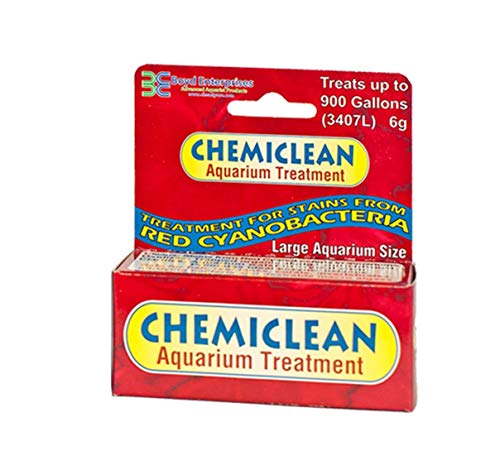
Chemiclean is a highly effective solution for marine aquariums that helps to remove stubborn stains caused by red, black, blue-green, and methane-producing cyanobacteria. It is also capable of oxidizing trapped organic sludge and sediment, resulting in a cleaner and clearer aquarium environment. With Chemiclean, you can enjoy a pristine and healthy aquarium ecosystem with ease.
This powerful formula works by promoting an ideal enzyme balance in your aquarium, ensuring that your fish and other aquatic creatures thrive in a healthy environment. It is easy to use and can quickly eliminate unsightly stains and buildup that can detract from the beauty of your aquarium.
Whether you are dealing with stubborn cyanobacteria stains or simply want to maintain a clean and clear aquarium, Chemiclean is a reliable and effective solution. It is specially formulated to target common aquarium issues and provide long-lasting results, ensuring that your aquarium stays healthy and beautiful for years to come.
With its powerful cleaning and clarifying properties, Chemiclean is an essential tool for any serious aquarium enthusiast. Whether you are new to the hobby or a seasoned pro, you can trust Chemiclean to provide the results you need to keep your aquarium looking and functioning at its best. Try it today and experience the difference for yourself!
2. Microbe-Lift Algaway 5.4 Algae Control For Fresh And Salt Water Home Aquariums, 8 Ounces
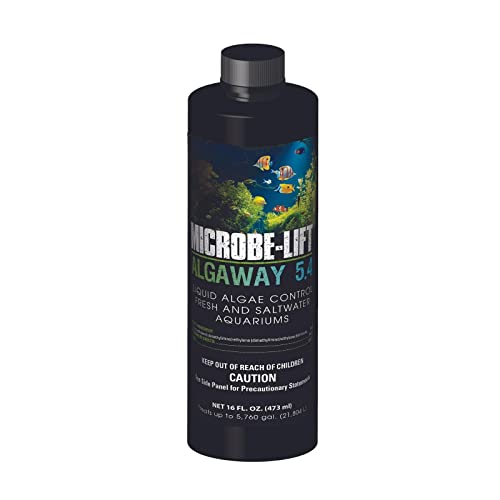
The aquarium is a delicate ecosystem that requires specific care to thrive. With the string and hair algae growth eliminator, maintaining a healthy aquarium has never been easier. This product quickly eliminates unsightly algae growth, promoting a healthier environment and reducing the need for excessive maintenance.
In addition to promoting healthier algae-free water, this product also eliminates unwanted algae that can lead to unpleasant odors within the aquarium. This means that the water in your aquarium will be cleaner and clearer, allowing for a better fish-viewing experience.
This product is an acceptable option for use in both fresh water and salt water aquariums. The protective formula is safe for all aquarium fish and ornamental plants. However, it is important to note that this product is not suitable for use with snails, shrimp, and other crustaceans or mollusks.
The application of the string and hair algae growth eliminator is simple and easy. It can be used in self-contained glass or acrylic aquariums, ornamental ponds, and fountains without any outflow. With this product, maintaining a healthy and thriving aquarium has never been easier.
3. Reef Sludge Dissolver For Crystal-Clear Aquariums
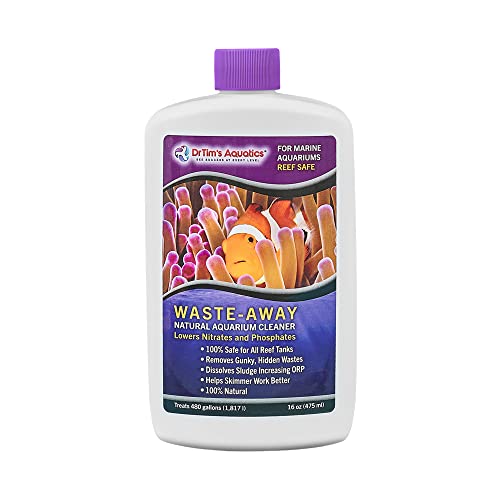
The Waste-Away aquarium cleaner is a reliable and reef safe solution for maintaining a clean and healthy aquarium environment. With its unique combination of bacteria, this effective solution effectively dissolves sludge, slime, dirt, and waste, while also reducing nitrates and phosphates for balanced water.
One of the key benefits of this aquarium cleaner is that it helps to extend the life of water filter pads, making it a cost-effective solution for aquarium maintenance. Additionally, regular use of Waste-Away can result in better water flow, increased oxygen, and an overall healthier aquarium environment.
This eco-friendly solution is designed to remove harmful gunk and unclog and sanitize gravel beds, making it an essential tool for any aquarium owner. Simply add the solution to your aquarium on a weekly basis for optimal results.
4. Ecological Labs Microbelift Special Blend (4 Oz)
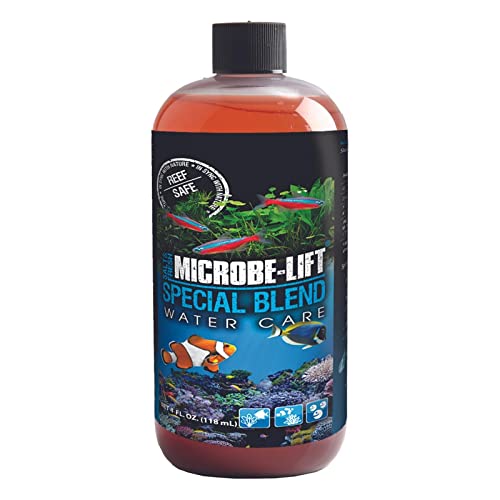
The Special Blend aquarium conditioner is a unique blend of formulated mixtures that creates a stable biological system in both freshwater and saltwater tanks. This aquarium conditioner is based on the blends used to clean lakes and rivers, making it an effective solution for maintaining a healthy environment for any fish.
One of the benefits of using the Special Blend aquarium conditioner is its ability to reduce the frequency of maintenance. It breaks down hard-to-degrade substances that create sludge and decrease water quality, resulting in cleaner water and a healthier environment for your fish.
Not only does the Special Blend aquarium conditioner improve the water quality, but it also promotes fish health. It provides a natural boost to improve coloring and helps fish digest more food, creating less food waste. Additionally, reduced ammonia levels create cleaner water, resulting in happier and healthier fish.
The Special Blend aquarium conditioner is safe for all fish, invertebrates, and plants in fresh, brackish, and saltwater tanks. It can be used in reef tanks as well, and you will notice better coloring and polyp extension from your corals when used regularly.
This aquarium conditioner also works great in planted tanks. In addition to its cleaning ability, the Special Blend increases carbon cycles and nutrient uptake in plants, resulting in better growth.
5. Chemi-Clean – 2 G
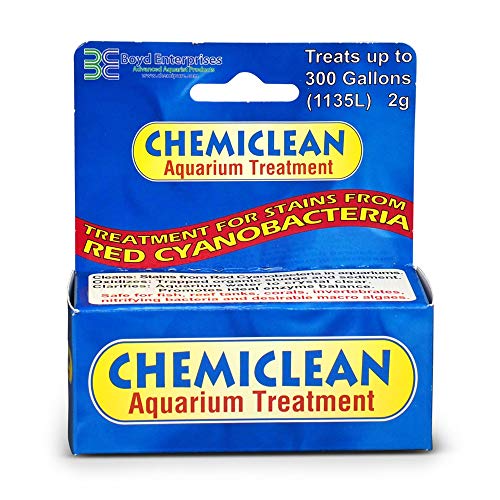
This powerful stain remover is a must-have for any aquarium enthusiast. Specifically designed to combat cyanobacteria stains, it is highly effective in both fresh and salt water. The best part? It's completely safe for all types of aquatic life, including fish, corals, invertebrates, nitrifying bacteria, and macro algae.
No need to worry about harmful chemicals or toxins – this stain remover is gentle yet powerful. Whether you're dealing with a small spot or a larger area, this product is sure to get the job done.
Suitable for all stages of aquarium life, this stain remover is a versatile addition to any aquarium maintenance routine. Keep your tank looking crystal clear with this highly effective and reliable product. Don't settle for anything less than the best – try it out for yourself today!
6. Seachem Pristine Aquarium Treatment, 250ml, Model Number: 67112410
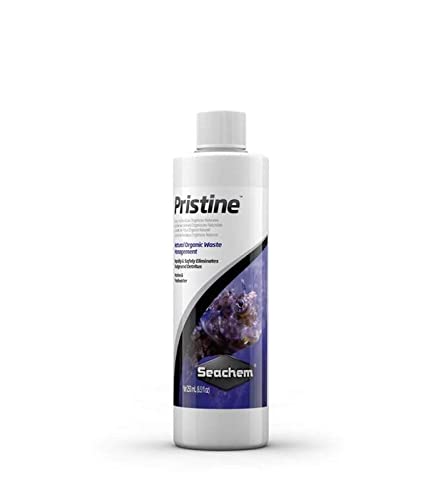
Looking for a natural solution to manage organic waste in your aquarium or pond? Look no further than this high-performing waste management product, designed to work effectively in both marine and freshwater environments.
This fast-acting formula is made with organic, all-natural ingredients that work quickly to break down and eliminate waste buildup. It's easy to use, with simple instructions that make it a breeze to incorporate into your regular maintenance routine.
Not only is this waste management solution effective, it's also affordable, making it a smart choice for budget-conscious aquarists and pond owners. You don't have to sacrifice performance for price with this product – it delivers top-notch results without breaking the bank.
So if you're looking for a natural, effective, and affordable way to manage organic waste in your aquatic environment, look no further than this high-quality waste management product.
7. Ultralife Blue Green Slime Stain Remover
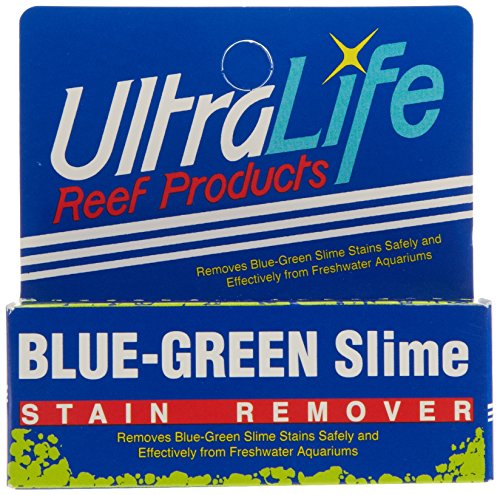
The Ultralife Reef Products Blue Green Algae Remover is a must-have for any aquarium enthusiast. This product effectively eliminates Blue Green Algae, allowing for the restoration of vibrant colors to your aquatic environment.
Adding this algae remover is a simple process that yields impressive results. The Blue Green Algae Remover is easy to use, making it an ideal choice for those who want a hassle-free solution to their aquarium woes. Once added, the product efficiently targets and eliminates Blue Green Algae, providing a noticeable difference in the coloring of your aquarium.
The Ultralife Reef Products Blue Green Algae Remover is a reliable solution to your aquarium's Blue Green Algae problem. Its effectiveness is due to its carefully selected parameters and specifications, designed to combat the stubborn Blue Green Algae. This product is safe for use in aquariums and does not cause any harm to your aquatic inhabitants.
8. Coralline
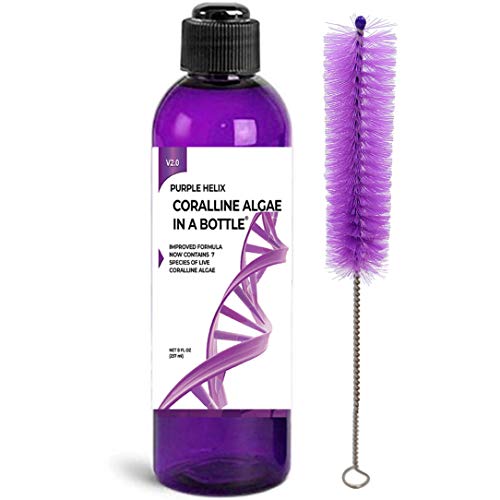
Looking for a fast and efficient way to add Coralline Algae to your aquarium? Look no further than the newest version of this product, which now includes two additional algae species to promote even more vibrant and diverse growth. Whether you're at the earliest stages of tank development or looking to add a splash of purple to an established aquarium, this product can help you achieve your goals quickly and easily.
To get started, simply use the product within 21 days of receiving it to ensure maximum freshness and efficacy. And with a recommended usage rate of one bottle per 50 gallons of tank volume, you can easily calculate the appropriate amount for your setup.
With its advanced formula and added algae species, this product is the perfect choice for anyone looking to promote healthy and diverse growth in their aquarium. So why wait? Try it out today and see the results for yourself!
9. Api Marine Algaefix
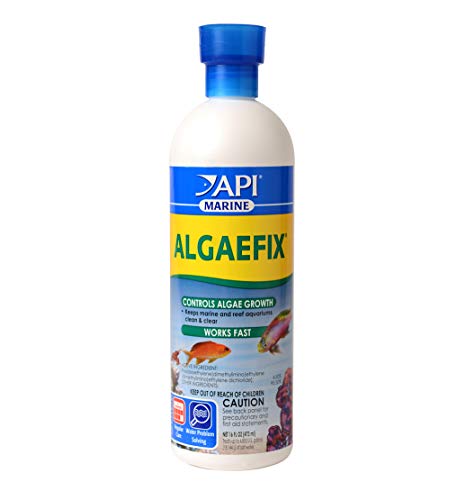
Introducing the API MARINE ALGAEFIX Algae Control 16-Ounce Bottle – the perfect solution for maintaining a clean and clear marine or reef aquarium. This product contains one bottle of API MARINE ALGAEFIX Algae Control, which is specially formulated to effectively control the growth of algae in saltwater aquariums.
This algae control solution is designed to target various types of saltwater algae, including Green algae (Cladophora), “Red Slime” (Oscillatoria / Spirulina major), and “Brown Algae” (Cyclotella). It is suitable for use in marine aquariums that contain live corals, invertebrates, and fish.
One of the best features of this product is its ability to control algae growth without harming other marine life. When used in saltwater, it is safe for snails, clams, scallops, shrimp, anemones, sea cucumbers, feather dusters, coralline algae, soft corals, hard corals, and other invertebrates.
Using API MARINE ALGAEFIX Algae Control is easy and straightforward. Simply dose every three days until the algae is under control, then dose weekly for maintenance. With regular use, this product can help keep your marine or reef aquarium clean and healthy.
Best Hair Algae Eater Reef FAQs
Are there any alternatives to hair algae eaters for controlling hair algae in a reef tank?
Yes, there are alternative ways to control hair algae in a reef tank. One option is to reduce the amount of nutrients in the water by performing regular water changes and using protein skimmers. This can help to limit the amount of nutrients available for hair algae growth. Another method is to introduce herbivorous fish species, such as tangs or rabbitfish, that will consume the hair algae. Additionally, some invertebrates, such as snails and hermit crabs, can also help to control hair algae growth. However, it is important to note that overfeeding and poor water quality can contribute to the growth of hair algae, so it is important to maintain a balanced and healthy reef environment. It is also important to identify the underlying cause of the hair algae growth and address any issues with lighting, water flow, or nutrient levels to prevent future outbreaks.
Are there any specific dietary requirements for hair algae eaters in a reef tank?
Hair algae eaters in a reef tank have specific dietary requirements that are essential for their health and well-being. These fish are known for their ability to consume hair algae, which can grow rapidly and become a nuisance in a reef tank. However, it is important to note that hair algae eaters cannot survive on hair algae alone and require a varied diet to thrive.
Most hair algae eaters are herbivores and require a diet that is rich in plant-based foods such as spirulina, seaweed, and algae sheets. These foods are readily available in most pet stores and can be easily added to the fish's diet. It is also important to ensure that the hair algae eaters are receiving enough protein in their diet, which can be accomplished by feeding them high-quality fish flakes or pellets.
In addition to a varied diet, hair algae eaters also require a clean and well-maintained tank environment. Regular water changes, proper filtration, and adequate lighting are all essential for the health and well-being of these fish. With the right diet and environment, hair algae eaters can thrive in a reef tank and help keep hair algae growth under control.
How do hair algae eaters compare to other methods of controlling hair algae growth in a reef aquarium?
Hair algae eaters, such as snails, crabs, and some species of fish, are an effective means of controlling hair algae growth in a reef aquarium. They are natural predators that can consume large amounts of hair algae, thus reducing its growth and spread in the tank.
Compared to other methods of controlling hair algae growth, such as chemical treatments and manual removal, hair algae eaters offer a more natural and sustainable solution. Chemical treatments can harm other organisms in the tank and may not be effective in the long term, while manual removal can be time-consuming and may not address the underlying cause of the algae growth.
However, it is important to note that hair algae eaters should not be relied upon as the sole method of controlling hair algae growth. Proper tank maintenance, such as regular water changes and maintaining appropriate nutrient levels, should also be practiced to prevent excessive hair algae growth.
Overall, hair algae eaters are a valuable addition to a reef aquarium and can play an important role in maintaining a healthy and balanced aquatic ecosystem.
How do hair algae eaters impact the overall health of a reef ecosystem?
Hair algae eaters, also known as algae grazers, play an important role in maintaining the overall health of a reef ecosystem. These species include various types of snails, crabs, and fish that feed on different kinds of algae, including hair algae.
The presence of hair algae in a reef ecosystem can cause a number of problems. It can overgrow and smother corals, reducing their ability to photosynthesize and compete for space. It can also reduce water flow, trap sediment, and alter the chemical composition of the water.
Algae grazers help to control hair algae growth by consuming it and preventing it from overrunning the reef. This promotes a more balanced and diverse ecosystem. In addition, these grazers provide food for other species, such as larger fish and invertebrates, which helps to support the entire food chain.
However, it's important to note that overfishing or removal of algae grazers can have negative effects on the reef ecosystem. Without these species to control algae growth, it can easily become unbalanced and lead to a decline in overall health. Therefore, it's crucial to maintain a healthy population of algae grazers in reef ecosystems.
How do water parameters affect the effectiveness of hair algae eaters?
Water parameters play a crucial role in the effectiveness of hair algae eaters. These algae eaters are typically fish or invertebrates that feed on hair algae, a common nuisance in aquariums. The optimal water parameters for these creatures vary depending on the species of the algae eater. However, certain factors such as pH, water hardness, and temperature can affect their ability to consume hair algae.
For instance, some species of hair algae eaters require a specific pH range between 7.0 to 8.5. If the pH is outside of this range, they may become stressed and less effective at consuming hair algae. Similarly, water hardness can impact an algae eater's ability to digest food and absorb nutrients. In general, a water hardness level between 6-10 dGH is ideal for most hair algae eaters.
Furthermore, temperature can also affect the metabolism and activity level of hair algae eaters. Most species prefer temperatures between 70-80°F, and cooler temperatures can slow down their digestion and metabolism. In contrast, higher temperatures can increase their activity levels, but it can also lead to lower oxygen levels in the water.
In summary, maintaining optimal water parameters is important for the health and effectiveness of hair algae eaters. It's essential to research the specific requirements of the species you plan to keep and adjust the water parameters accordingly.
What are the most common types of hair algae found in reef aquariums?
Hair algae is a common problem in reef aquariums and can be caused by a variety of factors such as excess nutrients, poor water flow, and lighting. There are several types of hair algae that can be found in reef aquariums, some of the most common ones include:
1. Green Hair Algae (GHA): This type of algae is probably the most common and is usually caused by high nutrient levels in the water. It can quickly take over the aquarium if not kept in check.
2. Blue-Green Algae (BGA): This algae is not actually a true algae but a type of bacteria. It forms slimy mats and can produce toxins that harm other aquarium inhabitants.
3. Red Algae: There are many types of red algae found in reef aquariums, some of which are desirable and others that are not. Some red algae can actually be beneficial as they provide a food source for some herbivorous fish.
4. Brush Algae: This type of algae forms tufts that resemble small brushes. It is usually caused by low CO2 levels and can be difficult to remove.
It is important to identify the type of hair algae present in the aquarium in order to determine the appropriate course of action to remove it.
What are the most effective hair algae eaters for a reef tank?
Hair algae can be a persistent problem in reef tanks, and controlling it can be a challenging task. However, there are several species of fish and invertebrates that can make a significant impact on hair algae growth in reef tanks.
One of the most effective hair algae eaters is the Mexican turbo snail. This species of snail has a hearty appetite for hair algae and can consume large amounts of it daily. Another effective option is the emerald crab, which is known for its ability to eat hair algae as well as other types of nuisance algae.
Certain species of tangs such as the sailfin tang and the yellow tang are also effective hair algae eaters. These fish have a herbivorous diet and will actively graze on hair algae in the tank.
Other options include the lawnmower blenny, which is a small fish that feeds on hair algae, and the Trochus snail, which has a similar diet to the Mexican turbo snail. It is important to note that while these species can help control hair algae growth, they should not be relied upon solely for prevention and should be supplemented with proper tank maintenance and water quality control.
What are the potential drawbacks of using hair algae eaters in a reef tank?
While hair algae eaters can be a helpful addition to a reef tank, there are also potential drawbacks to consider. One common type of hair algae eater is the hermit crab, which can be effective at consuming algae but may also damage corals or other tank inhabitants. Some species of fish, such as rabbitfish or tangs, are also known for their algae-eating abilities, but they may become aggressive towards other fish or may require a larger tank to thrive.
Another potential issue with using algae eaters is that they may not completely eliminate all types of algae in the tank. This can lead to a cycle of adding more and more algae eaters to keep up with the growth of the algae, which can ultimately lead to overstocking or other imbalances in the tank.
In addition, it is important to research and carefully select the right species of algae eaters for your specific tank environment. Some species may not be compatible with certain types of corals or other tank inhabitants, or may require specific water conditions or feeding requirements.
Overall, while algae eaters can be a helpful tool in maintaining a healthy reef tank, it is important to weigh the potential drawbacks and carefully consider their use in your specific tank setup.
What is the ideal number of hair algae eaters to have in a reef tank?
The ideal number of hair algae eaters to have in a reef tank depends on the size of the tank and the amount of hair algae present. A general rule of thumb is to have one algae eater for every 10 gallons of water. However, it's important to choose the right type of algae eater for your specific tank as some species may not be effective at controlling hair algae. Some popular hair algae eaters include snails, crabs, and certain species of fish such as tangs and blennies. It's also important to note that simply adding algae eaters may not be enough to completely eliminate hair algae. Proper aquarium maintenance, including regular water changes and proper lighting and nutrient levels, is also necessary to prevent hair algae growth. As always, it's best to consult with a knowledgeable aquarium professional to determine the best course of action for your specific reef tank.
Which fish or invertebrate is the best at controlling hair algae growth in a reef aquarium?
There are several fish and invertebrates that are known to help control hair algae growth in a reef aquarium. One of the most effective is the Foxface Rabbitfish (Siganus vulpinus). This fish has a voracious appetite for hair algae and will graze on it constantly, helping to keep it under control. Another popular choice is the lawnmower blenny (Salarias fasciatus), which is also known for its ability to consume hair algae.
In terms of invertebrates, the Mexican Turbo Snail (Turbo fluctuosa) is a great choice for controlling hair algae growth. These snails are herbivores and will consume a variety of algae, including hair algae. Additionally, the Scarlet Reef Hermit Crab (Paguristes cadenati) is another great option. These crabs are known for their ability to consume hair algae as well as other types of algae.
It is important to note that while these fish and invertebrates can be helpful in controlling hair algae growth, they should not be relied upon as the sole method of control. Proper aquarium maintenance, including regular water changes and nutrient control, is essential for maintaining a healthy and balanced reef aquarium.


